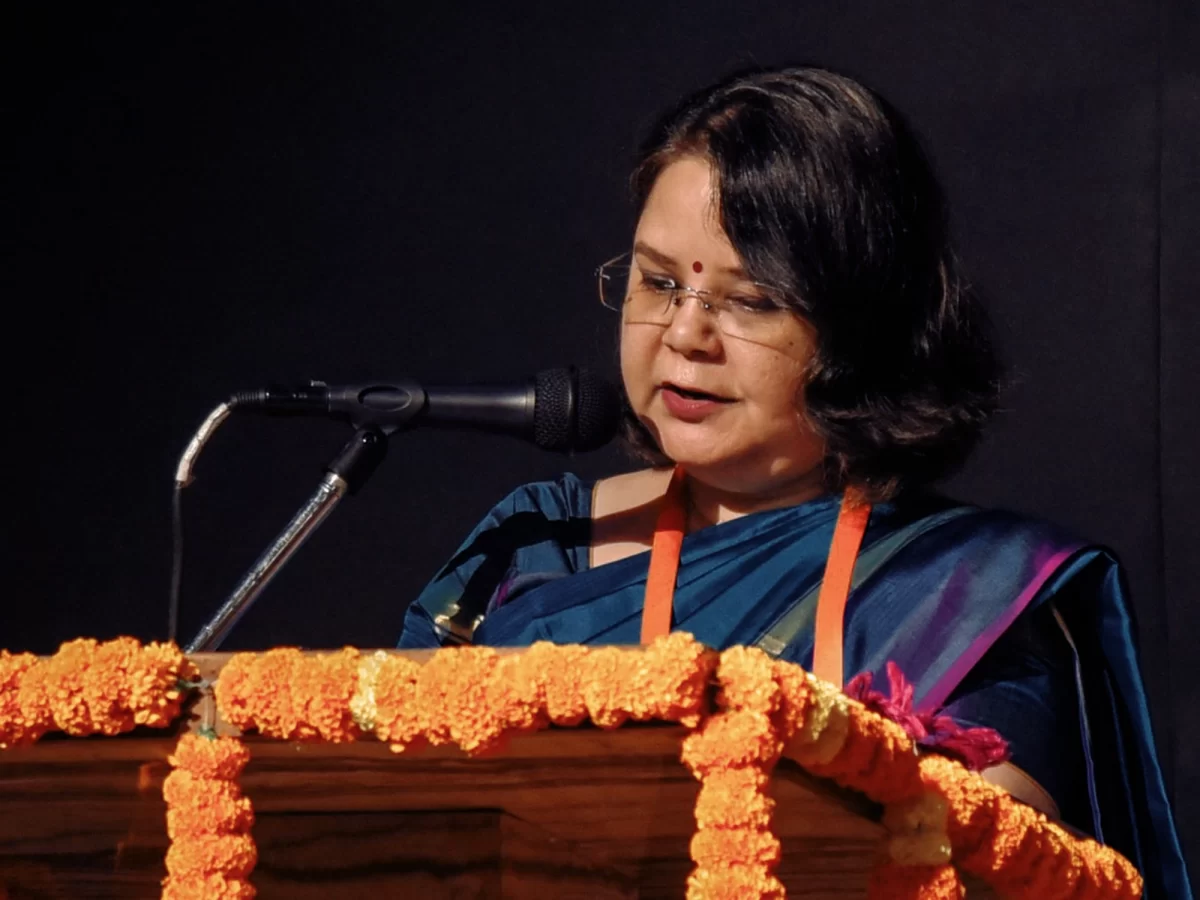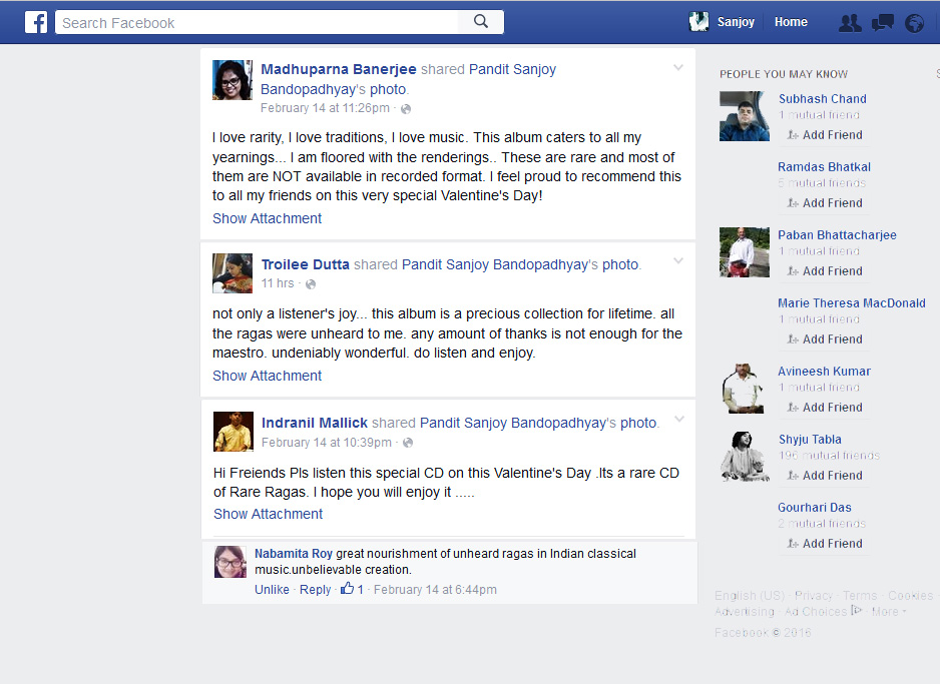Dr. Pragya Pyasi, an Assistant Professor of Music at the University of Hyderabad, specializes in Hindustani classical music (Sitar). A disciple of Pt. Sanjoy Bandopadhyay, Dr. Pragya earned her M.A. and M.Phil. from Indira Kala Sangeet Vishwavidyalaya, Khairagarh (University Topper), and a Ph.D. from Bhatkhande Sanskriti Vishwavidyalaya, Lucknow. She qualified for the UGC-NET in 2012. For the last few years, Dr. Pragya has received notable support from her Guru, Professor Bandopadhyay, in developing her advanced research skills and academic vision.
Dr. Pyasi has published extensively in UGC CARE and SCOPUS-indexed journals, focusing on music pedagogy, stylistic analysis, and interdisciplinary studies. She received the Best Research Paper Award (2022) from Naad Nartan Journal and has guided MPA students for their paper publications in CARE and Peer Reviewed Journals, with two receiving Best Paper Awards (2023). An Assistant Editor for Naad Nartan and reviewer for Shodhkosh, she has presented at national and international conferences and delivered lectures as a Guest Speaker at institutions like Banaras Hindu University, Indira Kala Sangeet Vishwavidyala, and Bhatkhande Sanskriti Vishwavidyalaya.
She serves on Boards of Studies, Examinations, and Research Advisory Committees of reputed institutions. A recipient of the National Scholarship (MHRD), she has performed at prestigious festivals and actively promotes Indian art and culture through NGOs and rural music workshops.
Detailed CV
Dr. Pragya Pyasi | Assistant Professor | Department of Music | SN School of Arts and Communication | University of Hyderabad
Phone: 9452669634 | Email: pragya.sitar at gmail.com and pragya at uohyd.ac.in
Educational Qualifications
- Ph.D (Bhatkhande Sangeet Sansthaan Sam Vishwavidyalaya, Lucknow, 2017)
- UGC NET (2012)
- M.Phil. (Sitar) – Indira Kala Sangit University Khairagarh (2003)
- M.A. (Sitar) – Indira Kala Sangit University Khairagarh (2002)
Specialization
Hindustani Classical Music – Sitar
Research Interests
Music pedagogy, Stylistic analysis of music, Interdisciplinary studies involving Music, allied art forms, and other disciplines.
Music Training
- Basic training of Sitar under Shri. Rajiv Keshav Kelkar (Jhansi)
- Currently learning sitar under Pandit Sanjoy Bandopadhyay, the eminent sitar maestro, academician, and an exemplary Guru.
Professional Associations
- Member of Research Advisory Committee at the Department of Performing Arts, Assam University Silchar (a central university).
- Assistant Editor in Naad-Nartan Journal of Dance and Music.
- A reviewer with Shodhkosh: Journal of Visual and Performing Arts
- Member of the panel of examiners for UG, PG, and Ph.D by Indira Kala Sangit Vishwavidyalay, Khairagarh
- Member, Board of Studies, National Sanskrit University, Tirupati.
Awards
- ‘Best Research Paper Award’ by ‘Naad Nartan’ Journal of Dance and Music for the paper ‘Presence of Hindustani Raga Music on YouTube and the Relative Positionings of the Musicians and Music Rendering Styles’ (2022)
Publications
- The article “Impact of Globalisation on Indian Music After Independence” in the book New Dimensions in Indian Music (Kanishka Publications, New Delhi, 2012)
Articles
- ‘Kandinsky and Mishra’s Synesthetic Approach in Portraying Music: A Comparative Analysis’ with Dr. Mukta Kulshreshtha IMEJ, International Multidisciplinary e-Journal (ISSN – 2277 -4262) in September 2024.
- ‘Comparing Emotional Quotients: A Study of Undergraduate and Postgraduate Students in Music and Non-music Disciplines’ in UGC CARE listed journal Sangeet Galaxy (ISSN: 2319 – 9695), Vol. 13, No.2 (July 2024).
- ‘Music Preferences and Consumption Habits Among Students of Hyderabad University: A Study Based on Digital Music Platforms’ Co-authored with Mohit Mehta in UGC CARE listed Naad Nartan Journal of Dance and Music, Volume: 12, Issue-2, April 2024 (ISSN: 2349-4654).
- ‘Comparative Analysis of Ghazals and Nazrul Geeti: Exploring Musical and Cultural Dimensions’ co-authored with Rakiba Islam Oyshi and Saugat Mani Rasily in UGC CARE listed Naad Nartan Journal of Dance and Music, Volume: 12, Issue-2, April 2024 (ISSN: 2349-4654).
- ‘Four Generations of Imadādkhānī Gharānā: A Critical Study of Jhālā’ in Pranav Journal of Fine Arts (ISSN- 2582-9513), Volume -2, Issue – 4, in February 2024.
- ‘A Comparative Study of Kanhaiyā daṃgal and Huraṃgā of Rajasthan A Participant’s Observation’ in Pranav Journal of Fine Arts (ISSN- 2582-9513), Volume -2 Issue – 4, in February, 2024.
- ‘Do the YouTube views count reflects the seniority and acceptance of Indian classical musicians within fraternity or the vice-versa?’ In UGC-CARE Listed Journal “ Naad-Nartan Journal of Dance & Music ” Volume -10, Issue-1, (ISSN: 2349-4654) , June 20227.
- ‘Defining Hindustani Raga musicians and their relative intra statuses: An analytical study’ (published in a Web of Science and SCOPUS indexed journal ‘Rupkatha,’ Vol XIII, Apr-June, 2021).
- Aesthetic and Literary Visualisation of Raga (published in Saam Bharati – 2019).
- Methods and Sources of Data Collection for Research in Music (published in International Inventive Multidisciplinary Journal- 2018).
- Divyata Ki Chhaap (Published in Bhartiyata – 2018).
- Music Therapy: An Experiment with My Students (published in Music Therapy2011).
- saMgIta meM dUrastha shikShaNa: saMbhAvanAeM (published in Kala Saurabh 2011).
Academic Outreach
Seminars
- Presented a research paper titled ‘Impact of Indian Classical Music Exposure on Student’s Cultural Intelligence: A Study Focused on University of Hyderabad Students’ at the National conference organized by Naad Nartan at Bhatkhande Sanskriti Vishwavidyalaya, Lucknow, from the 26-28th September 2024.
- Presented a research paper titled ‘Tradition Redefined: Pandit Sanjoy Bandopadhyay’s Innovative Approach to Sitar Pedagogy’ at the International Seminar on Media and the Changing Landscape of Music held during 13-14th March, 2024 organised by the Department of Instrumental Music, Rabindra Bharati University, Kolkata.
- Presented a research paper titled ‘A Critical Review of Work Done by Indian Scholars on Computer Music During the Last Three Decades’ 5th 3-Day National Seminar on Music and Technology organized by the esteemed organization ‘Naad Nartan’ in association with the Ministry of Culture, Govt of India; in Jaipur, from 21st to the 23rd September 2023.
- Presented a research paper titled ‘Exploration of Innovations and Traditional Knowledge Transfer Methods in Pandit Sanjoy Bandopadhyay’s Indian Classical Music Pedagogy: A Case Study’ at the Two-day International Conference on Indian Music (ICIM 2023) held during 6-7th November, 2023 organized by School of Liberal and Creative Arts (Films, Theatre and Music), Lovely Professional University, Punjab.
- Presented a research paper titled ‘Comparing Emotional Quotients: A Study of Undergraduate and Postgraduate Students in Music and Non-music Disciplines’ at the International Conference on Interdisciplinary Possibilities in Music, held during 6-7th December 2023, organized by the Department of Music, Girdari Lal Dogra Memorial Government Degree College, Hiranagar, in collaboration with Department of Higher Education UT J&K.
- Presented a research paper titled “Four Generations of Imadādkhānī Gharānā: A Critical Study of Jhālā” in “Parishodhana”, the Two day National Conference on Musical Forms and Indian Music and Temple Dance traditions, organized by JAIN (Deemed-to-be University), Bengaluru (January 27th-28th, 2023)
- Co-authored and guided a research paper titled “A Comparative Study of Kanhiyā Daṃgal and Huraṁgā of Rajasthan: A Participant’s Observation” with an MPA IV Semester student Mohit Mehta for “Parishodhana”, the Two day National Conference on Musical Forms and Indian Music and Temple Dance traditions, organized by JAIN (Deemed-to-be University), Bengaluru (January 27th-28th, 2023)
- Presented a research paper titled “Does the YouTube View Counts Reflect the Seniority and Acceptance of Indian Classical Musicians within the Fraternity or the Vice-Versa?” in the 4th Two day National Seminar organized by Naad Nartan in association with the Ministry of Culture, Govt. of India. (February 12 th -13 th , 2022).
- Presented a paper at an International Seminar organized by Banglar Puratattva Gabeshana Kendra Kolkata on “Aesthetic and Literary Visualisation of Raga” 23/11/2018
- Presented a paper at an International Seminar organized by SNDT Pune on “Methods and Sources of Data Collection for Research in Music” – 06/10/2018
- Presented a paper at an International Seminar organised by Maharaja Sayajirao University Baroda on “svAtaMtryottara kAla meM saMgIta kA saMrakShaNa”- 29/03/16
- Presented a paper at an International Seminar organized by Indira Kala Sangit University Khairagarh on “Impact of Globalisation on Indian Music After Independence”– 26/02/12
- Presented a paper at an International Seminar organised by Kriti Kala Sansthaan, Agra, on “Arts Funding in India”– 28/01/12
- Presented a paper titled “Music Therapy : An Experiment With My Students”at a National Seminar organized by DGPG College Kanpur – 04/12/10
Papers Co-authored
- ‘Ayodhya’s Kirtan Tradition and Its Socio-Cultural Aspects and Connections’ with Dr. Asmita Mishra at the 6th National conference organised by Naad Nartan at Bhatkhande Sanskriti Vishwavidyalaya, Lucknow, from the 26-28th September, 2024.
- ‘The Significance of Print Media in Preserving and Popularizing Indian Classical Music’ with Dr. Asmita Mishra for the 5th 3-Day National Seminar on ‘Music and Technology’ organised by the ‘Naad Nartan’ in association with the Ministry of Culture, Govt of India in Jaipur, from the 21st to the 23rd September 2023.
- ‘Kandinsky and Mishra’s Synesthetic Approach in Portraying Music: A Comparative Analysis’ with Dr. Mukta Kulshreshtha for the International Conference on Interdisciplinary Possibilities in Music, held from 6-7th December 2023, organized by the Department of Music, Girdari Lal Dogra Memorial Government Degree College, Hiranagar in collaboration with Department of Higher Education UT J&K.
Students’ Papers Guided and Co-authored
- ‘Music Preferences and Consumption Habits Among Students of Hyderabad University: A Study Based on Digital Music Platforms’ – Mohit Mehta (Awarded Best Paper)
- “Comparative Analysis of Ghazals and Nazrul Geeti: Exploring Musical and Cultural Dimensions” – Rakiba Islam Oyishi and Saugat Mani Rasily (Awarded Youngest Researcher’s Award)
- ‘Light Classical Forms in Odissi and Hindustani Music: Uncovering Similarities and Differences’ – Sai Sudeep Das
- ‘Kanhaiyā Dangal: A Cultural Confluence of Faith and Entertainment’ – Mohit Mehta
- ‘Exploring Hindustani Raga Music Components in Nusrat Fateh Ali Khan’s Qawwali Performances’ – Karan Malik
- ‘Analysis of the YouTube Presence of Hindustani Raga Music Vocalists with Special Reference to the Gender and Genre Dynamics’ – Prerana Sharma
- ‘Structural Analysis of Taan-s in Pandit Nikhil Banerjee’s Sitar Performances: Study on selected commercial recordings’ – Saugat Mani Rasaily
Professional Activities
- Performed in various cities and participated in several cultural meets
- Winner in several University level competitions and UP Sangeet Natak Academy State level competition
- Awarded National Scholarship from the Ministry of Human Resource Development (2001)
Other Activities
- Published literary works in Kadambini
- Associated with two NGOs working for Indian Art and Culture
- Worked as Director of AAROHAN (Jhansi) and Secretary of TWISHA, Jeypore (Odisha)
- Organized programs and competitions at the state level in UP and Odisha
- Organized workshops in schools in remote areas of Odisha and Uttar Pradesh














